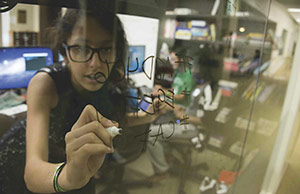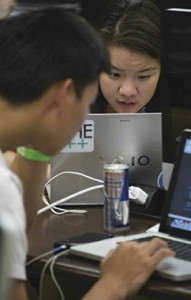Class Program
{
public static void Main()
{
System.Console.WriteLine( “Hello, world!” );
}
}
Even if you’re the kind of person who tells new acquaintances at dinner parties that you hate email and e-books, you probably recognize the words above as being some kind of computer code. You may even be able to work out, more or less, what this little ‘program’ does: it writes to the console of some system the line ‘Hello, world!’
 A geek hunched over a laptop tapping frantically at the keyboard, neon-bright lines of green code sliding up the screen—the programmer at work is now a familiar staple of popular entertainment. The clipped shorthand and digits of programming languages are familiar even to civilians, if only as runic incantations charged with world-changing power. Computing has transformed all our lives, but the processes and cultures that produce software remain largely opaque, alien, unknown. This is certainly true within my own professional community of fiction writers—whenever I tell one of my fellow authors that I supported myself through the writing of my first novel by working as a programmer and a computer consultant, I evoke a response that mixes bemusement, bafflement and a touch of awe, as if I’d just said that I could levitate. Most of the artists I know—painters, film-makers, actors, poets —seem to regard programming as an esoteric scientific discipline; they are keenly aware of its cultural mystique, envious of its potential profitability, and eager to extract metaphors, imagery and dramatic possibility from its history, but coding may as well be nuclear physics as far as relevance to their own daily practice is concerned.
A geek hunched over a laptop tapping frantically at the keyboard, neon-bright lines of green code sliding up the screen—the programmer at work is now a familiar staple of popular entertainment. The clipped shorthand and digits of programming languages are familiar even to civilians, if only as runic incantations charged with world-changing power. Computing has transformed all our lives, but the processes and cultures that produce software remain largely opaque, alien, unknown. This is certainly true within my own professional community of fiction writers—whenever I tell one of my fellow authors that I supported myself through the writing of my first novel by working as a programmer and a computer consultant, I evoke a response that mixes bemusement, bafflement and a touch of awe, as if I’d just said that I could levitate. Most of the artists I know—painters, film-makers, actors, poets —seem to regard programming as an esoteric scientific discipline; they are keenly aware of its cultural mystique, envious of its potential profitability, and eager to extract metaphors, imagery and dramatic possibility from its history, but coding may as well be nuclear physics as far as relevance to their own daily practice is concerned.
Many programmers, on the other hand, regard themselves as artists. Since programmers create complex objects and care not just about function but also about beauty, they are just like painters and sculptors. The best-known assertion of this notion is the essay ‘Hackers and Painters’ by programmer and venture capitalist Paul Graham. ‘What hackers and painters have in common is that they’re both makers. Along with composers, architects and writers, what hackers and painters are trying to do is make good things.’
According to Graham, the iterative processes of programming—write, debug (discover and remove bugs, which are coding errors, mistakes), rewrite, experiment, debug, rewrite—exactly duplicate the methods of artists: ‘The way to create something beautiful is often to make subtle tweaks to something that already exists, or to combine existing ideas in a slightly new way … You should figure out programs as you’re writing them, just as writers and painters and architects do.’ Attention to detail further marks good hackers with artist-like passion:
All those unseen details [in a Leonardo da Vinci painting] combine to produce something that’s just stunning, like a thousand barely audible voices all singing in tune. Great software, likewise, requires a fanatical devotion to beauty. If you look inside good software, you find that parts no one is ever supposed to see are beautiful too.
This desire to equate art and programming has a lengthy pedigree. In 1972, the famed computer scientist Butler Lampson published an editorial titled ‘Programmers as Authors’ which began:
Creative endeavor varies greatly in the amount of overhead (i.e. money, manpower and organization) associated with a project which calls for a given amount of creative work. At one extreme is the activity of an aircraft designer, at the other that of a poet. The art of programming currently falls much closer to the former than the latter. I believe, however, that this situation is likely to change considerably in the next decade.
Lampson’s argument was that hardware would become so cheap that ‘almost everyone who uses a pencil will use a computer,’ and that these users would be able to use ‘reliable software components’ to put together complex programs. ‘As a result, millions of people will write non-trivial programs, and hundreds of thousands will try to sell them.’
 A poet, however, might wonder why Lampson would place poetry making on the same spectrum of complexity as aircraft design, how the two disciplines—besides being ‘creative’—are in any way similar. After all, if Lampson’s intent is to point towards the future reduction of technological overhead and the democratization of programming, there are plenty of other technical and scientific fields in which the employment of pencil and paper by individuals might produce substantial results. Architecture, perhaps, or carpentry, or mathematics. One thinks of Einstein in the patent office at Bern. But even the title of Lampson’s essay hints at a desire for kinship with writers, an identification that aligns what programmers and authors do and makes them—somehow, eventually—the same.
A poet, however, might wonder why Lampson would place poetry making on the same spectrum of complexity as aircraft design, how the two disciplines—besides being ‘creative’—are in any way similar. After all, if Lampson’s intent is to point towards the future reduction of technological overhead and the democratization of programming, there are plenty of other technical and scientific fields in which the employment of pencil and paper by individuals might produce substantial results. Architecture, perhaps, or carpentry, or mathematics. One thinks of Einstein in the patent office at Bern. But even the title of Lampson’s essay hints at a desire for kinship with writers, an identification that aligns what programmers and authors do and makes them—somehow, eventually—the same.
Both writers and programmers struggle with language. The code at the beginning of this chapter is in Microsoft’s C#, one of thousands of high-level programming languages invented over the last century.
Each of these is a ‘formal language,’ a language ‘with explicit and precise rules for its syntax and semantics,’ as the Oxford Dictionary of Computing puts it. Formal languages ‘contrast with natural languages such as English whose rules, evolving as they do with use, fall short of being either a complete or a precise definition of the syntax, much less the semantics, of the language.’ So these formal dialects may be less flexible and less forgiving of ambiguity than natural languages, but coders—like poets—manipulate linguistic structures and tropes, search for expressivity and clarity. While a piece of code may pass instructions to a computer, its real audience, its readers, are the programmers who will add features and remove bugs in the days and years after the code is first created. Donald Knuth is the author of the revered magnum opus on computer algorithms and data structure, The Art of Computer Programming. Volume 3 of the Art was published in 1973; the first part of Volume 4 appeared in 2011; the next part is ‘under preparation.’ If ever there was a person who fluently spoke the native idiom of machines, it is Knuth, computing’s greatest living sage. More than anyone else, he understands the paradox that programmers write code for other humans, not for machines: ‘Let us change our traditional attitude to the construction of programs: Instead of imagining that our main task is to instruct a computer what to do, let us concentrate rather on explaining to human beings what we want a computer to do.’ In 1984, therefore, he famously formalized the notion of ‘literate programming’:
The practitioner of literate programming can be regarded as an essayist, whose main concern is with exposition and excellence of style. Such an author, with thesaurus in hand, chooses the names of variables carefully and explains what each variable means. He or she strives for a program that is comprehensible because its concepts have been introduced in an order that is best for human understanding, using a mixture of formal and informal methods that reinforce each other.
Good code, then, is marked by qualities that go beyond the purely practical; like equations in physics and mathematics, code can aspire to elegance. Knuth remarked about the code of a compiler that it was ‘plodding and excruciating to read, because it just didn’t possess any wit whatsoever. It got the job done, but its use of the computer was very disappointing.’
To get the job done—a novice may imagine that this is what code is supposed to do. Code is, after all, a series of commands issued to a dumb hunk of metal and silicon and plastic animated by electricity. What more could you want it to do, to be? Knuth answers: code must be ‘absolutely beautiful.’ He once said about a program called SOAP (Symbolic Optimal Assembly Program) that ‘reading it was like hearing a symphony, because every instruction was sort of doing two things and everything came together gracefully.’
We are now unmistakably in the realm of human perception, taste and pleasure, and therefore of aesthetics. Can code itself—as opposed to the programs that are constructed with code—be beautiful? Programmers certainly think so. Greg Wilson, the editor of Beautiful Code, an anthology of essays by programmers about ‘the most beautiful piece of code they knew,’ writes in his forward to that book:
I got my first job as a programmer in the summer of 1982. Two weeks after I started, one of the system administrators loaned me Kernighan and Plauger’s The Elements of Programming Style … and Wirth’s Algorithms + Data Structures = Programs. … [These books] were a revelation—for the first time, I saw that programs could be more than just instructions for computers. They could be as elegant as well-made kitchen cabinets, as graceful as a suspension bridge, or as eloquent as one of George Orwell’s essays.
Knuth himself is careful to limit the scope of his aesthetic claims: ‘I do think issues of style do come through and make certain programs a genuine pleasure to read. Probably not, however, to the extent that they would give me any transcendental emotions.’ But in the many discussions that programmers have about craftsmanship, elegance and beauty, there is an unmistakable tendency to assert—as Wilson does—that code is as ‘eloquent’ as literature. …
The day that millions will dash off beautiful programs—as easily as with a pencil—still remains distant. The ‘lovely gems and brilliant coups’ of coding remain hidden and largely incomprehensible to outsiders. But the beauty that programmers pursue leads to their own happiness, and—not incidentally—to the robustness of the systems they create, so the aesthetics of code impact your life more than you know.
This excerpt from Geek Sublime: The Beauty of Code, the Code of Beauty (Graywolf Press), by Vikram Chandra ’84, is published with permission of the author. In his first venture into nonfiction, the noted novelist roams from logic gates to the writings of 11th-century Indian philosopher Abhinavagupta, in search of connections between the worlds of art and technology.
Photos accompanying this excerpt are from the Spring 2014 Hackathon held at Pomona College and are by John Lucas.
